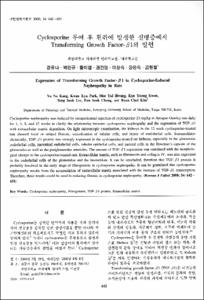Cyclosporine 투여 후 흰쥐에 발생한 신병증에서 Transforming Growth Factor-β1의 발현
- Keimyung Author(s)
- Kang, Yu Na; Park, Kwan Kyu; Kwon, Kun Young; Lee, Sang Sook; Chang, Eun Sook; Kim, Hyun Chul
- Journal Title
- 대한병리학회지
- Issued Date
- 2000
- Volume
- 34
- Issue
- 9
- Abstract
- Cyclosporine nephropathy was induced by intraperitoneal injection of cyclosporine 25 mg/kg in Sprague-Dawley rats daily for 1, 4, 8, and 12 weeks to clarify the relationship between cyclosporine nephropathy and the expression of TGF-beta1 with extracellular matrix deposition. On light microscopic examination, the kidneys in the 12 week cyclosporine-treated rats showed focal or striped fibrosis, vacuolization of tubular cells, and injury of endothelial cells. Immunohistochemically, TGF-beta1 protein was strongly expressed in the cyclosporine-treated rat kidneys, especially in the glomerular endothelial cells, interstitial endothelial cells, tubular epithelial cells, and parietal cells in the Bowman's capsule of the glomerulus as well as the periglomerular arterioles. The amount of TGF-beta1 expression was correlated with the morphological change in the cyclosporine-treated rats. Extracellular matrix, such as fibronectin and collagen IV, was also expressed in the endothelial cells of the glomerulus and the interstitium. It can be concluded, therefore that TGF-beta1 protein is probably involved in the early stage of fibrogenesis in cyclosporine nephropathy. It can be postulated that cyclosporine nephropathy results from the accumulation of extracellular matrix associated with the increase of TGF-beta1 transcription. Therefore, these results could be used in reducing fibrosis in cyclosporine nephropathy.
Key Words: Cyclosporine nephropathy; Fibrogenesis; TGF-beta1 protein; Extracellular matrix
- Alternative Title
- Expression of Transforming Growth Factor-β1 in Cyclosporine-Induced Nephropathy in Rats.
- Publisher
- School of Medicine
- Citation
- 강유나 et al. (2000). Cyclosporine 투여 후 흰쥐에 발생한 신병증에서 Transforming Growth Factor-β1의 발현. 대한병리학회지, 34(9), 642–651.
- Type
- Article
- ISSN
- 0379-1149
- Appears in Collections:
- 1. School of Medicine (의과대학) > Dept. of Internal Medicine (내과학)
1. School of Medicine (의과대학) > Dept. of Pathology (병리학)
- 파일 목록
-
-
Download
 oak-bbb-1096.pdf
기타 데이터 / 20.88 MB / Adobe PDF
oak-bbb-1096.pdf
기타 데이터 / 20.88 MB / Adobe PDF
-
Items in Repository are protected by copyright, with all rights reserved, unless otherwise indicated.